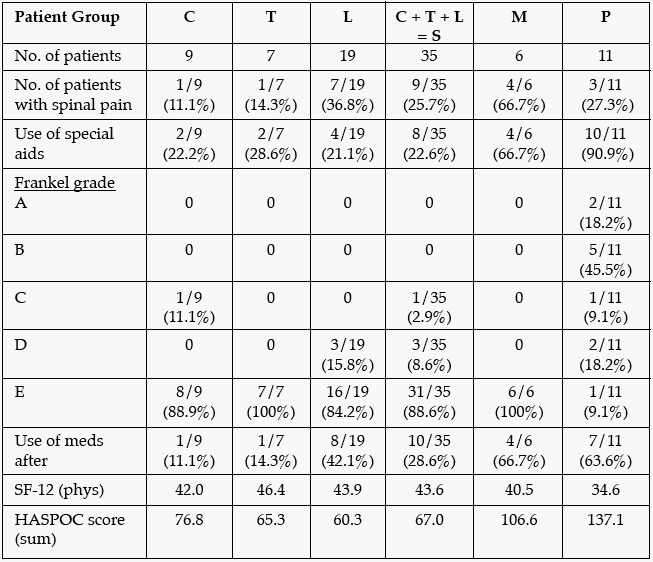
Thurs., 10/16/08 Spine, Paper #1, 2:25 pm OTA-2008
Spinal Fractures in Multiple Trauma Patients - What Is the Outcome at a Follow-up Interval of Ten Years and More?
Sophie Darwiche, MD1 (n);
Christian Probst, MD2 (a-Grant by H & S Re Insurance Company, Grant from Medartis,
Basel, Switzerland); Jennifer Steel, PhD1 (n);
Ralf Lohse, MD, PhD3 (e-H & S Re Insurance Company);
Christian Krettek, MD2 (a-AO Foundation);
Nicola A. Sittaro, MD3 (a-H & S Re Insurance Company);
Hans-Christoph Pape, MD1 (a-AO Foundation, Grant by H & S Re Insurance Company) ;
1University of Pittsburgh Medical Center, Pittsburgh, Pennsylvania, USA;
2Hannover Medical School, Hannover, Germany;
3Hannover-Re, Hannover, Germany
Purpose: As data on long-term outcomes of polytrauma patients with spinal fractures are sparse, we present this information with a special emphasis on polytrauma patients over a minimum 10-year follow-up interval.
Methods: We assessed 52 polytrauma patients with spinal fractures. Clinical outcome was determined via clinical examination by a physician and patient assessment, and included measurement of pain, Frankel grade, ISS score, mean SF-12 score, mean Hannover Score for Polytrauma Outcome (HASPOC score), the use of special aids and of medications, and the number of associated injuries, including the number of lower extremity injuries. The patients were classified according to the anatomic region of the spinal injury: cervical (C), thoracic (T), lumbar (L), fractures in multiple regions (M), and traumatic paraplegia (P). Some patients in a single-region category had multiple fractures at multiple levels within that region.
Results: The mean age at time of injury was 27.6 years (range, 6-51), and mean time interval for follow-up was 16.0 years (range, 10-23). The demographics and initial injury severity of the 5 groups were statistically similar (using χ2, Mann-Whitney U, and Fisher exact tests).

Conclusions: The polytrauma patients with only single-region spinal fractures had the best long-term outcome. Those patients with multiple-region spinal fractures had a statistically worse outcome than the single-region category in terms of Frankel grade, use of special aids, medications, and the HASPOC and SF-12 scores. The worst outcome was found in paraplegic patients in all variables assessed. The outcome of the multiple group patients is almost comparable to the paraplegics at long-term follow-up.
Significance: Polytrauma patients and patients who had spine trauma at multiple levels do particularly poorly even at 10 years after trauma. Patients with multiple-level injuries do almost as poorly as initial paraplegics and represent a special problem. These injury combinations should be a focus of special attention in the future.
If noted, the author indicates something of value received. The codes are identified as a-research or institutional support; b-miscellaneous funding; c-royalties; d-stock options; e-consultant or employee; n-no conflicts disclosed, and *disclosure not available at time of printing.
• The FDA has not cleared this drug and/or medical device for the use described in this presentation (i.e., the drug or medical device is being discussed for an “off label” use). ◆FDA information not available at time of printing. Δ OTA Grant